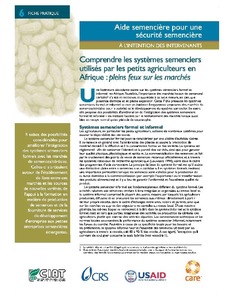Aide semenciere pour une securite semenciere: a l'intention des intervenants
No. 2 presents an
overview of the Country Case
Studies
undertaken to guide the design of the tools
presented in Briefs 8 to 10 as well as to examine the
effects of different types of interventions. The case
studies were undertaken in Burundi, Ethiopia, Kenya,
Malawi, Mozambique, Uganda and Zimbabwe.
No. 3 introduces the general
concept of seed
security
and differentiates parameters of availability,
access, and seed and variety quality, as well as
distinguishing chronic from acute stress.
Briefs 4 and 5 consider focused topics that cut
across seed assistance and seed security. No. 4
addresses issues of
relief and agobiodiversity
: the
importance of diversity in stabilizing systems and
the possible effects of various relief approaches
in maintaining, enhancing, or undermining such
diversity. No. 5 focuses on the opportunities and
risks of using seed aid to move beyond the
status
quo ante
by
introducing seed of new varieties
(or
indeed, new crops altogether).
Briefs 6 and 7 present short overviews of
practice. No. 6 looks at the range of seed systems
routinely used by small farmers in Africa and
highlights the escalating
importance of local
markets
. Effective interventions depend on a solid
understanding of such standard seed procurement
practices. No. 7 sketches the
current major seed-
system based response options
, and reflects on their
appropriateness in relation to the stresses on hand.
The last set of briefs focus on tools and guidance.
No. 8 examines how effective interventions depend
on sound and timely assessment, which requires
both a
tool to assess seed system security
and
the knowledge and skill to use it. No. 9 starts to
bring the cycle to a close by giving guidance on
evaluating seed-aid projects
, suggesting the types of
evaluation needed and their content. The final brief
then looks to the future and suggests a
checklist for
the development of proposals for seed assistance
.
It is this last which builds on the range of lessons
learned.

